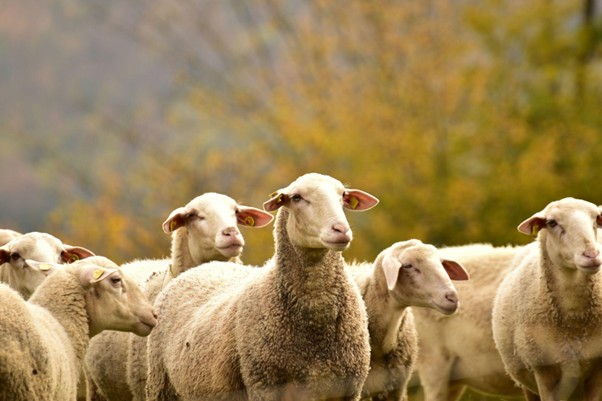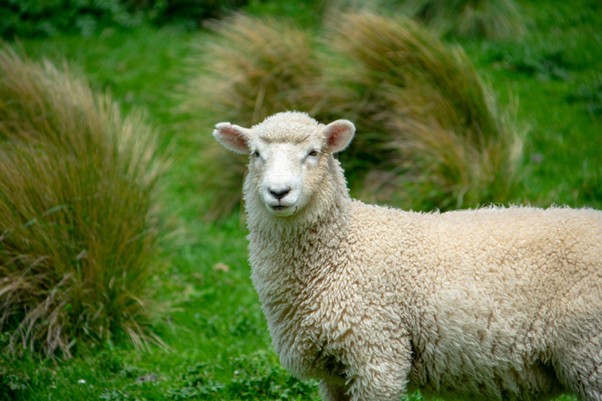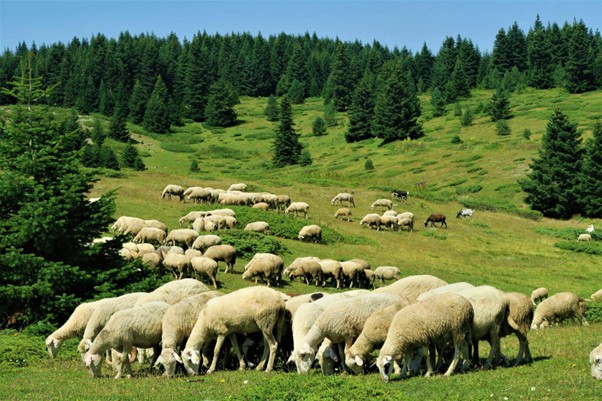Common Parasites in Sheep: Prevention, Treatment & Hygiene Tips

Sheep parasites are one of the most costly and recurring problems farmers face. They reduce productivity, damage the quality of their wool, cause a range of health issues, and lower reproductive efficiency across the flock.
Sheep are more susceptible to parasites than any other livestock because of their grazing habits, which increase exposure to infection. To protect flock health and maintain profitability, farmers must understand the major types of parasites and adopt effective control measures.
Common Parasites in Sheep

Sheep are vulnerable to both external and internal parasites, which can affect their health, productivity, and overall performance. Understanding these parasites, their active seasons, high-risk periods, and transmission routes is key to effective control.
External Parasites in Sheep
Common external parasites include lice, mites, and ticks. These parasites irritate the sheep's skin, cause discomfort, and can lead to severe disease if left untreated.
Lice
Lice are small, wingless insects that feed on the skin and blood of the animals. They cause irritation and stress and may damage the wool.
- Symptoms: Itching, hair loss, scabs, restlessness, and poor coat condition.
- Season: Most active in late fall to early spring, especially in cooler weather.
- High-Risk Periods: During winter or when sheep are housed closely together.
- Transmission: Spread through direct contact between animals or contaminated brushes, feeders, and equipment.
Mites
Mites are tiny arachnids that burrow into the skin or live on its surface, leading to severe itching.
- Symptoms: Hair loss, thickened or scaly skin, scabs, and intense scratching.
- Season: Mostly active in colder months.
- High-Risk Periods: Winter and periods of poor hygiene or overcrowding.
- Transmission: Direct contact with infected animals or contaminated bedding and housing.
Ticks
Ticks attach to the sheep's skin and feed on blood. They may transmit diseases such as anaplasmosis and babesiosis.
- Symptoms: Anemia, skin irritation, scabs, weight loss, and restlessness.
- Season: Most active in warm, humid months (spring through late summer).
- High-Risk Periods: During grazing in tick-infested pastures or brushy areas.
- Transmission: From infested vegetation or through direct contact in crowded pens.
Sheep Keds
Sheep keds are wingless flies that live in the fleece and feed on the sheep's blood, causing irritation and discomfort.
- Symptoms: Intense itching, wool loss, skin thickening, scabs, and reduced wool quality.
- Season: Most active in the cooler months (autumn to spring).
- High-Risk Periods: When sheep are housed closely together or have long, dense wool.
- Transmission: Spread through direct contact between infested and healthy sheep, especially during shearing or handling.
Blowflies
Blowflies lay eggs in damp or soiled areas of fleece, and the hatched larvae (maggots) feed on the sheep's skin, leading to flystrike (a painful and often fatal condition).
- Symptoms: Foul odor, irritation, wool staining, restlessness, reduced grazing, and visible maggots on the skin.
- Season: Most common in warm, humid months—late spring to early autumn.
- High-Risk Periods: During rainy or humid weather and in sheep with soiled or wet fleece.
- Transmission: Adult flies are attracted to moist or dirty fleece, laying eggs that hatch into skin-feeding larvae.
Internal Parasites in Sheep
Common internal parasites include barber's pole worm, tapeworms, liver flukes, and coccidia. These parasites primarily affect the digestive system, nutrient absorption, and immunity.
Barber's Pole Worm
A blood-sucking worm found in the stomach that causes severe anemia and weakness.
- Symptoms: Pale eyelids and gums, bottle jaw (fluid under the jaw), weight loss, and lethargy.
- Season: Most active in warm, wet seasons.
- High-Risk Periods: Late spring to early fall when pastures are moist.
- Transmission: Ingestion of larvae from contaminated pasture or feed.
Coccidia
Microscopic protozoa that infect the intestinal lining, especially in young goats.
- Symptoms: Diarrhea (sometimes bloody), dehydration, poor growth, and rough coat.
- Season: Thrive in warm, damp environments.
- High-Risk Periods: During weaning and stress periods; most common in crowded pens.
- Transmission: Ingestion of oocysts from contaminated feed, water, or bedding.
Liver Fluke
Liver flukes are flatworms that infect the liver and bile ducts. They cause tissue damage and impair liver function.
- Symptoms: Weight loss, anemia, lethargy, bottle jaw, reduced appetite.
- Season: Most common in wet or marshy grazing areas.
- High-Risk Periods: Late summer to fall in areas with standing water or snails.
- Transmission: Ingestion of infective cysts (metacercariae) on contaminated grass; requires snails as intermediate hosts.
Lungworms
Parasitic worms that inhabit the lungs and lay eggs to cause respiratory distress.
- Symptoms: Persistent coughing, nasal discharge, difficulty breathing, and weight loss.
- Season: More common in cool, moist conditions.
- High-Risk Periods: During extended wet weather or overcrowded housing.
- Transmission: Ingestion of larvae from contaminated pasture or feed.
Brown Stomach Worm
A stomach worm that interferes with digestion and nutrient absorption.
- Symptoms: Diarrhea, loss of appetite, weight loss, dull coat.
- Season: Active during cool, wet seasons.
- High-Risk Periods: Early spring and fall.
- Transmission: Ingestion of larvae from contaminated pastures.
Tapeworms
Flat intestinal worms that absorb nutrients, often affecting growth in young goats.
- Symptoms: Weight loss, pot-bellied appearance, digestive upset, visible worm segments in feces.
- Season: Year-round, depending on intermediate host presence.
- High-Risk Periods: During grazing, when intermediate hosts (like mites) are abundant.
- Transmission: Ingestion of intermediate hosts carrying tapeworm larvae.
Symptoms of Parasites Affect Your Sheep

The table below summarizes common symptoms of parasites and their effects for quick reference.
Risk Periods for Parasites in Sheep

Certain stages and conditions make sheep more vulnerable to parasite infestations. Recognizing these high-risk periods helps farmers take preventive steps to protect flock health and productivity.
Young Sheep
Lambs and young sheep have developing immune systems, making them highly prone to both internal and external parasites.
Pregnant/Lactating Sheep
Ewes experience reduced immunity during late pregnancy and lactation, increasing their susceptibility to parasites and affecting milk production and lamb health.
High-Density Flocks
Crowded housing or grazing areas promote the rapid spread of parasites through direct contact and contaminated environments.
Wet, Warm Seasons
Parasite populations thrive in moist and warm conditions, especially after rainfall, increasing the risk of infestations.
Overgrazed or Short Pastures
When pastures are short, sheep graze closer to the ground, where most parasite larvae and eggs are found, leading to higher infection rates.
Purchasing New Sheep
Introducing new animals without quarantine or deworming can bring parasites into a healthy flock, triggering fresh outbreaks.
Complications from Parasite Infections in Sheep

Parasite infections can lead to a range of health and productivity issues in sheep. The severity of these complications often depends on the animal's age, condition, and parasite load, with young lambs and older ewes being most affected.
Effects on Young Sheep
Lambs are particularly vulnerable as their immune systems are still developing. Heavy parasite infestations can cause:
- Poor growth and weight loss
- Diarrhea and dehydration
- Weakness and lethargy
- Anemia and bottle jaw
- Increased risk of secondary infections
Effects on Adult Sheep
While adult sheep may tolerate low levels of parasites, chronic infections can still have significant impacts on performance. Common complications include:
- Reduced wool quality and yield
- Lower reproductive success and fertility
- Weight loss and poor body condition
- Decline in milk production
- Increased vulnerability to other diseases due to weakened immunity
How to Control Parasites in Sheep
Effective parasite control in sheep relies on a combination of preventive management, strategic treatment, and good hygiene practices.
Internal Parasite Control in Sheep
- Deworm strategically; base your treatments on fecal egg counts rather than routine schedules.
- Rotate pastures to break parasite life cycles and reduce reinfection.
- Avoid overstocking; keep stocking densities low to reduce contamination.
- Provide clean water and feed to prevent ingestion of parasite eggs.
- Supplement nutrition with minerals and protein to boost immunity.
- Use targeted dewormers suitable for the specific parasites identified.
External Parasite Control in Sheep
- Regularly inspect wool and skin for signs of lice, mites, keds, and flystrike.
- Shear and crutch sheep before warm or wet seasons to reduce flystrike risk.
- Use topical treatments or dips to control lice, keds, and mites effectively.
- Maintain clean housing; make sure to remove manure and soiled bedding frequently.
- Control flies around housing areas with traps and proper waste management.
General Parasite Control in Sheep
- Quarantine new sheep and deworm before mixing with the main flock.
- Monitor parasite loads regularly through veterinary fecal testing.
- Rotate dewormer classes to prevent drug resistance.
- Provide clean, dry shelter to reduce exposure to external parasites.
- Keep records of treatments and pasture use to track parasite trends.
Expert Suggestions for Effective Parasite Control in Sheep
Consistent monitoring, smart timing, and preventive care are key to keeping parasites under control and maintaining flock productivity.
Best Time to Deworm
- Deworm before major risk seasons, typically before the wet or warm months when parasite activity rises.
- Treat ewes before lambing to reduce contamination and protect newborn lambs.
- Use fecal egg count testing to determine the right timing and avoid unnecessary treatments.
- Deworm newly purchased or returning sheep before adding them to the main flock.
Natural Remedies That Help
- Tannin-rich plants such as chicory, sericea lespedeza, and sainfoin naturally suppress internal worms.
- Herbal additives like garlic, pumpkin seeds, and neem may support gut health and reduce parasite load.
- Diatomaceous earth (food grade) can help limit external parasites when used safely and correctly.
- Maintain clean, dry housing and regular shearing to discourage fly and lice infestations naturally.
Common Mistakes Farmers Make
- Overusing dewormers, which leads to parasite resistance.
- Skipping fecal testing and relying solely on routine deworming.
- Ignoring external parasite control and focusing only on internal worms.
- Not quarantining new animals, which in turn allows parasites to spread to the herd.
- Overlooking record-keeping and not seeking timely veterinary intervention to treat the symptoms.
Signs That Parasite Control Is Working
You can tell the infestation is under control by the wool quality, steady weight gain, and improved grazing behavior. Sheep become more alert, show fewer signs of scratching or irritation, and their droppings appear firm and normal. Reduced anemia and improved lambing outcomes are also strong signs that your parasite management program is working.
Use FarmKeep for Sheep Management
Whether you manage a small flock or a large-scale operation, keeping track of sheep health and breeding is crucial for productivity and profitability. FarmKeep, the all-in-one farm management app, makes it simple.
With FarmKeep, you can:
- Log sheep health records such as vaccinations, deworming dates, lambing history, and treatments.
- Track breeding cycles, lambing dates, and genetic records.
- Set reminders for shearing, parasite control, and feed schedules.
- Access detailed insights to improve flock health and reduce losses.
FAQs
How often should I deworm sheep?
Farmers are advised to deworm when there is a clear indication of disease or high risk, based on animal condition and management context, rather than treat routinely purely for prevention.
How can I naturally control ticks and flies in sheep?
To control ticks and flies in sheep, farmers must keep pastures trimmed, maintain clean housing, use natural repellents like neem oil or garlic sprays, and remove manure regularly to reduce breeding sites.
How can I protect sheep during pregnancy from parasites?
Provide optimal nutrition, maintain clean and dry housing, avoid overstocking, and treat ewes strategically before lambing to reduce parasite exposure.
What are the common intestinal parasites in sheep?
The most common intestinal parasites in sheep are barber's pole worm, brown stomach worm, liver fluke, lungworms, tapeworms, and coccidia.
What are the key symptoms of parasitism in sheep?
Key symptoms of parasitism in sheep are weight loss, poor growth, diarrhea, anemia (pale gums), bottle jaw, wool loss or poor fleece quality, weakness, and lethargy.
How do I prevent and control parasite outbreaks in sheep?
Practice rotational grazing, maintain hygiene in housing and pastures, strategically deworm high-risk sheep, isolate new animals, and monitor flock health regularly.



